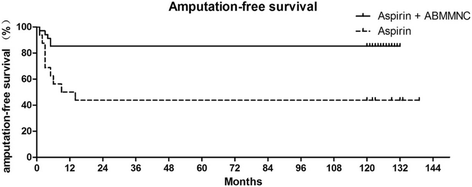Autologous bone marrow-derived mononuclear cell therapy in Chinese patients with critical limb ischemia due to thromboangiitis obliterans: 10-year results
- PMID: 29471870
- PMCID: PMC5824551
- DOI: 10.1186/s13287-018-0784-6
Autologous bone marrow-derived mononuclear cell therapy in Chinese patients with critical limb ischemia due to thromboangiitis obliterans: 10-year results
Abstract
Background: For patients with thromboangiitis obliterans (TAO), revascularization with bypass or angioplasty is frequently not feasible due to the poor outflow of the distal small vessels. We evaluated the long-term results of our experience treating patients with TAO with autologous bone marrow-derived mononuclear cells (ABMMNCs) to determine the safety and efficacy of ABMMNC therapy in patients with critical limb ischemia due to TAO.
Methods: This was a retrospective chart review from a single university hospital vascular surgery center between January 2005 and July 2006. Patients were treated with smoking cessation and either aspirin (100 mg/day) alone or aspirin and ABMMNC injection according to patient preference. Groups were compared for demographics, clinical characteristics, and short-term and long-term results.
Results: Of 59 patients with TAO who were treated, 19 patients elected aspirin alone and 40 patients elected aspirin and ABMMNC injection. No patients suffered perioperative complications and 49 (83%) patients remained smoke-free for 10 years. The 10-year amputation-free survival was 85.3% (29/34) in patients treated with ABMMNCs compared to 40% (6/15) in patients treated with aspirin alone (p = 0.0019). Ulcer area (p < 0.0001), toe-brachial index (TBI; p < 0.0001), transcutaneous oxygen pressure (TcPO2; p < 0.0001), and pain score (p < 0.0001) were also significantly improved with ABMMNC treatment, although there was no difference in mean ankle-brachial index (ABI; p = 0.806).
Conclusions: In patients with critical limb ischemia due to TAO, ABMMNC treatment was safe and effective. ABMMNC treatment significantly improved amputation-free survival, ulcer healing, and pain, although there is no difference in ABI compared to treatment with aspirin alone.
Keywords: Bone marrow; Critical limb ischemia; Mononuclear cell; Thromboangiitis obliterans.
Conflict of interest statement
Ethics approval and consent to participate
Ethics approval for the study was obtained from the Xuanwu Hospital review board and all patients provided written informed consent to participate in the study.
Consent for publication
All related patients and all authors agreed and signed the consent form.
Competing interests
The authors declare that they have no competing interests.
Publisher’s Note
Springer Nature remains neutral with regard to jurisdictional claims in published maps and institutional affiliations.
Figures




Similar articles
-
Autologous bone-marrow mononuclear cell implantation for patients with Rutherford grade II-III thromboangiitis obliterans.J Vasc Surg. 2006 Oct;44(4):732-9. doi: 10.1016/j.jvs.2006.06.023. Epub 2006 Aug 22. J Vasc Surg. 2006. PMID: 16926085
-
A Multicenter Prospective Interventional Trial of Therapeutic Angiogenesis Using Bone Marrow-Derived Mononuclear Cell Implantation for Patients With Critical Limb-Threatening Ischemia Caused by Thromboangiitis Obliterans.Circ J. 2023 Aug 25;87(9):1229-1237. doi: 10.1253/circj.CJ-23-0046. Epub 2023 Mar 10. Circ J. 2023. PMID: 36908168
-
Therapeutic angiogenesis in Buerger's disease (thromboangiitis obliterans) patients with critical limb ischemia by autologous transplantation of bone marrow mononuclear cells.J Vasc Surg. 2008 Dec;48(6 Suppl):53S-60S; discussion 60S. doi: 10.1016/j.jvs.2008.09.005. J Vasc Surg. 2008. PMID: 19084740
-
Endovascular Treatment of Thromboangiitis Obliterans (Buerger's Disease).Vasc Endovascular Surg. 2018 Feb;52(2):124-130. doi: 10.1177/1538574417744085. Epub 2017 Dec 13. Vasc Endovascular Surg. 2018. PMID: 29237360 Review.
-
Efficacy and Safety of Autologous Cell-based Therapy in Patients with No-option Critical Limb Ischaemia: A Meta-Analysis.Curr Stem Cell Res Ther. 2018;13(4):265-283. doi: 10.2174/1574888X13666180313141416. Curr Stem Cell Res Ther. 2018. PMID: 29532760 Review.
Cited by
-
REX-001, a BM-MNC Enriched Solution, Induces Revascularization of Ischemic Tissues in a Murine Model of Chronic Limb-Threatening Ischemia.Front Cell Dev Biol. 2020 Dec 9;8:602837. doi: 10.3389/fcell.2020.602837. eCollection 2020. Front Cell Dev Biol. 2020. PMID: 33363160 Free PMC article.
-
Molecular identity of arteries, veins, and lymphatics.J Vasc Surg. 2019 Jan;69(1):253-262. doi: 10.1016/j.jvs.2018.06.195. Epub 2018 Aug 25. J Vasc Surg. 2019. PMID: 30154011 Free PMC article. Review.
-
Autologous Stem Cells Transplantation for No-Option Angiitis-Induced Critical Limb Ischemia: Recurrence and New Lesion.Stem Cells Transl Med. 2022 May 27;11(5):504-512. doi: 10.1093/stcltm/szac017. Stem Cells Transl Med. 2022. PMID: 35446404 Free PMC article.
-
Long-term follow-up of patients with Buerger's disease after autologous stem cell therapy.Anatol J Cardiol. 2019 Mar;21(3):155-162. doi: 10.14744/AnatolJCardiol.2018.12354. Anatol J Cardiol. 2019. PMID: 30821715 Free PMC article.
-
Thromboangiitis Obliterans: Changing Demographics for a Preventable Disease.Cureus. 2019 Jan 11;11(1):e3869. doi: 10.7759/cureus.3869. Cureus. 2019. PMID: 30899620 Free PMC article.
References
-
- Tateishi-Yuyama E, Matsubara H, Murohara T, Ikeda U, Shintani S, Masaki H, Amano K, Kishimoto Y, Yoshimoto K, Akashi H, et al. Therapeutic angiogenesis for patients with limb ischaemia by autologous transplantation of bone-marrow cells: a pilot study and a randomised controlled trial. Lancet. 2002;360:427–435. doi: 10.1016/S0140-6736(02)09670-8. - DOI - PubMed
Publication types
MeSH terms
Substances
LinkOut - more resources
Full Text Sources
Other Literature Sources
Medical

